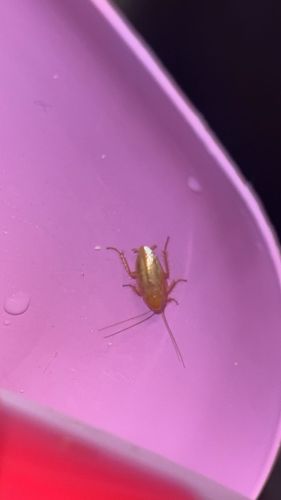German Cockroach
Scientific Name: Blattella germanica
Order & Family: Blattodea, Blattellidae
Size: 1.1 to 1.6 cm (0.43 to 0.63 inches) in length as adults. The individual in the image appears to be a nymph, which is smaller.

Natural Habitat
Primarily indoor pests; prefers warm, humid, and dark places close to food and water sources, such as kitchens, bathrooms, and food preparation areas in homes, restaurants, and other commercial buildings.
Diet & Feeding
Omnivorous scavengers; feeds on almost anything, including food scraps, grease, starches, sweets, pet food, and even non-food items like soap, glue, and toothpaste.
Behavior Patterns
Nocturnal; hides in cracks and crevices during the day. Known for rapid reproduction, especially in warm, humid environments. Can infest quickly and spread. They are fast runners and can be difficult to catch. Nymphs typically have a white stripe down their back, which is visible in the image.
Risks & Benefits
Risks: German cockroaches are significant pests. They can contaminate food and surfaces with bacteria (e.g., Salmonella, E. coli), allergens, and pathogens, leading to food poisoning, gastroenteritis, and triggering asthma attacks and allergic reactions in sensitive individuals. They are also carriers of parasitic worms and other human pathogens. Benefits: No notable benefits to humans; in natural ecosystems, they act as decomposers, but their primary habitat is indoors.
Identified on: 9/3/2025